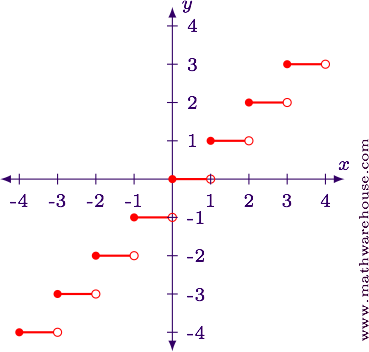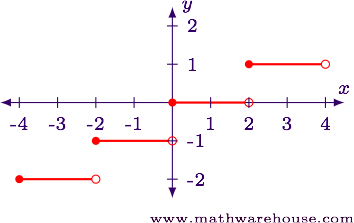Quick Overview
- The Greatest Integer Function is also known as the Floor Function.
- It is written as $$f(x) = \lfloor x \rfloor$$.
- The value of $$\lfloor x \rfloor$$ is the largest integer that is less than or equal to $$x$$.
Definition
The Greatest Integer Function is defined as
$$\lfloor x \rfloor = \mbox{the largest integer that is}$$ less than or equal to $$x$$.
In mathematical notation we would write this as
$$ \lfloor x\rfloor = \max\{m\in\mathbb{Z}|m\leq x\} $$
The notation "$$m\in\mathbb{Z}$$" means "$$m$$ is an integer".
Examples
Example 1---Basic Calculations
Evaluate the following.
- $$\lfloor 2.7\rfloor$$
- $$\lfloor -1.4 \rfloor$$
- $$\lfloor 8\rfloor$$
-
If we examine a number line with the integers and 2.7 plotted on it, we see
![]()
The largest integer that is less than 2.7 is 2. So $$\lfloor 2.7\rfloor = 2$$.
-
If we examine a number line with the integers and -1.3 plotted on it, we see
![]()
Since the largest integer that is less than -1.3 is -2, so $$\lfloor -1.3\rfloor = -2$$.
-
Since $$\lfloor x\rfloor =$$ the largest integer that is less than or equal to $$x$$, we know $$\lfloor 8\rfloor = 8$$.
Graphing the Greatest Integer Function
To understand the behavior of this function, in terms of a graph, let's construct a table of values.
TABLE$$ \begin{array}{|c|c|} \hline x & \lfloor x \rfloor\\ \hline -1.5 & -2\\ -1.25 & -2\\ -1 & -1\\ -0.75 & -1\\ -0.5 & -1\\ -0.25 & -1\\ 0 & 0\\ 0.25 & 0\\ 0.5 & 0\\ 0.75 & 0\\ 1 & 1\\ 1.25 & 1\\ 1.5 & 1\\ \hline \end{array} $$
The table shows us that the function increases to the next highest integer any time the x-value becomes an integer. This results in the following graph.
Answer
Example 2
Sketch a graph of $$y = \left\lfloor \frac 1 2x \right\rfloor$$.
SolutionWe know what the basic graph should look like, so we just need to understand how the factor of $$\frac 1 2$$ is going to affect things. We can do this in two ways: we can make a table of values, or we can interpret this as a transformation.
TABLE
$$ \begin{align*} \begin{array}{|c|c|c|} \hline x & \frac 1 2 x & \left\lfloor \frac 1 2 x\right\rfloor\\[6pt] \hline -2 & -1.5 & -2\\[6pt] -1.5 & -0.75 & -1\\[6pt] -1 & -0.5 & -1\\[6pt] -0.5 & -0.25 & -1\\[6pt] 0 & 0 & 0\\[6pt] 0.5 & 0.25 & 0\\[6pt] 1 & 0.5 & 0\\[6pt] 1.5 & 0.75 & 0\\[6pt] 2 & 1 & 1\\[6pt] \hline \end{array} \end{align*} $$
We notice from the table that the function values jump to the next value when $$x$$ is even.
TRANSFORMATION
We can interpret $$y = \left\lfloor \frac 1 2 x\right\rfloor$$ as a horizontal stretch which doubles the length of each piece.
Answer:
Solving Equations
There is a formula that can help us when working with equations that involve the floor function.
$$\lfloor x\rfloor = m\qquad\mbox{if and only if}\quad m \leq x < m + 1$$
(remember, $$m$$ is an integer!)
So, for example, $$\lfloor x\rfloor = 8$$ if and only if $$8 \leq x < 9$$.
Example 3
Solve the equation $$\lfloor 2x + 5\rfloor = 9$$.
Step 1Rewrite the equation using the inequality.
$$9 \leq 2x + 5 < 10$$
Step 2Solve the inequality.
$$ \begin{align*} 9 & \leq 2x + 5 < 10\\ 9 - 5 & \leq 2x < 10 - 5\\ 4 & \leq 2x < 5\\ \frac 4 2 & \leq x < \frac 5 2\\[6pt] 2 & \leq x < 2.5 \end{align*} $$
Answer:In interval notation, the equation is true for $$x \in [2, 2.5)$$.
Example 4
Solve the equation $$\lfloor 1.25 + \lfloor x\rfloor\rfloor = 12$$.
Step 1Replace $$\lfloor x\rfloor$$ with $$u$$. This is called a "change of variable" and it will make the equation easier to work with.
$$ \begin{align*} \lfloor 1.25 + \lfloor x\rfloor\rfloor & = 12\\[6pt] \lfloor 1.25 + u\rfloor & = 12 \end{align*} $$
Step 2Replace the equation with one of the inequalities, where $$m = 12$$
Solve the inequality.
$$ \begin{align*} 12 & \leq 1.25 + u < 13\\[6pt] 10.75 & \leq u < 11.75\\[6pt] 10.75 & \leq \lfloor x \rfloor < 11.75 \end{align*} $$
Since $$\lfloor x \rfloor$$ is an integer, the only way to satisfy the above inequalities is for $$\lfloor x \rfloor = 11$$.
Step 4Determine the value of $$x$$.
Again, using the inequalities, we know
$$ 11 \leq x < 12 $$
Answer:$$ 11 \leq x < 12 $$
















